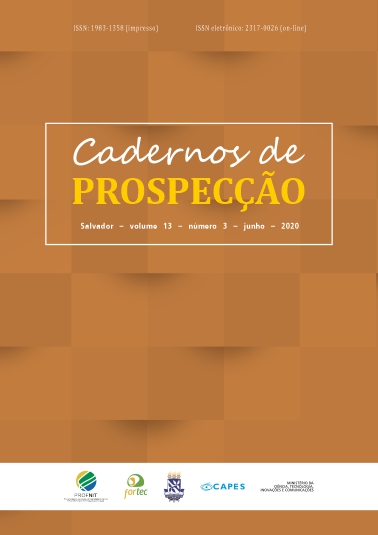Prospective Study on Medicine Preparations of Green Tea
DOI:
https://doi.org/10.9771/cp.v13i3.29340Keywords:
Camellia Sinensis, Medicinal Preparations, Therapeutic Property.Abstract
Green tea is considered the second most popular and healthy drink since antiquity, second only to water. Thus, the present study aims to conduct a technological prospection on patents that address the therapeutic properties of green tea for human health. The searches were performed through the Espacenet , INPI and Patentscope patent database in June 2018 under the word green tea and code A61K36 / 82. The number of patent filings per year, it is possible to see an increase (even with some fluctuations) in the number of filings over the years. South Korea, the US and China are the countries with the most patents. Regarding the therapeutic applications of developed green tea patents, it is noted that dermatological treatment is the most outstanding, followed by treatment for overweight and treatment of metabolic diseases.
Downloads
References
AMPARO, K. K. S.; RIBEIRO, M. C. O.; GUARIEIRO, L. L. N. Estudo de caso utilizando mapeamento de prospecção tecnológica como principal ferramenta de busca científica. Perspectivas em Ciência da Informação, [S.l.], v. 17, n. 4, p. 195-209, 2012.
BARBOSA, E. M. A. O. et al. Análise dos Pedidos de Patentes Recentes Envolvendo Chá Verde e suas Propriedades. Cadernos de Prospecção, Salvador, v. 11, n. 2, p. 559, 2018.
BESSA, N. G. F. et al. Prospecção fitoquímica preliminar de plantas nativas do cerrado de uso popular medicinal pela comunidade rural do assentamento vale verde–Tocantins. Revista Brasileira de Plantas Medicinais, [S.l.], v. 15, n. 4, p. 692-707, 2013.
BUTT, M. S. et al. Green tea and anticancer perspectives: updates from last decade. Critical Reviews in Food Science And Nutrition, [S.l.], v. 55, n. 6, p. 792-805, 2015.
DEKANT, W. et al. Safety assessment of green tea based beverages and dried green tea extracts as nutritional supplements. Toxicology Letters, [S.l.], v. 277, p. 104-108, 2017.
GARNICA, L. A.; OLIVEIRA, R. M.; TORKOMIAN, A. L. V. Propriedade intelectual e titularidade de patentes universitárias: um estudo piloto na Universidade Federal de São Carlos-UFSCar. In: XXIV SIMPÓSIO DE GESTÃO DA INOVAÇÃO TECNOLÓGICA, 2006. Anais [...], 2006.
INPI – INSTITUTO NACIONAL DA PROPRIEDADE INDUSTRIAL. Classificação Internacional de Patentes. 2018. Disponível em: https://www.gov.br/inpi/pt-br/assuntos/patentes/classificacao-de-patentes. Acesso em: 2 dez. 2018.
LAMARÃO, R. C.; FIALHO, E. Aspectos funcionais das catequinas do chá verde no metabolismo celular e sua relação com a redução da gordura corporal. Revista de Nutrição, [S.l.], 2009.
LIMA, J. D. et al. Tea: aspects related to the quality and prospects. Ciência Rural, [S.l.], v. 39, n. 4, p. 1.258-1.266, 2009.
MANFREDINI, V.; MARTINS, V. D.; BENFATO, M. S. Chá verde: benefícios para a saúde humana. Infarma – Ciências Farmacêuticas, [S.l.], v. 16, n. 9/10, p. 68-70, 2013.
MELO, M. E. Doenças Desencadeadas ou Agravadas pela Obesidade. Associação Brasileira para Estudos da Obesidade e Síndrome Metabólica (ABESO), São Paulo (SP); 2011.
MIYAZAKI, S. F. Utilização do chá verde em cosméticos. Cadernos de Prospecção, Salvador, v. 1, n. 1, p. 10-13, 2009.
MOMOSE, Y.; MAEDA-YAMAMOTO, M.; NABETANI, H. Systematic review of green tea epigallocatechin gallate in reducing low-density lipoprotein cholesterol levels of humans. International Journal of Food Sciences and Nutrition, [S.l.], v. 67, n. 6, p. 606-613, 2016.
PARK, H. J. et al. Green tea extract attenuates hepatic steatosis by decreasing adipose lipogenesis and enhancing hepatic antioxidant defenses in ob/ob mice. The Journal of Nutritional Biochemistry, [S.l.], v. 22, n. 4, p. 393-400, 2011.
SAEED, M. et al. Green tea (Camellia sinensis) and L-theanine: Medicinal values and beneficial applications in humans – a comprehensive review. Biomedicine & Pharmacotherapy, [S.l.], v. 95, p. 1.260-1.275, 2017.
SANTOS, U. et al. Avaliação de potencial de ervas medicinais: Capim-limão (Cymbopogon citratus dc), Chá verde (Camellia sinensis l.) E hibisco (Hibiscus sabdariffa l.) Para obtenção de chás solúveis. Revista GEINTEC-Gestão, Inovação e Tecnologias, [S.l.], v. 4, n. 4, p. 1.399-1.408, 2014.
SENGER, A. E. V.; SCHWANKE, C. H. A.; GOTTLIEB, M. G. V. Chá verde (Camellia sinensis) e suas propriedades funcionais nas doenças crônicas não transmissíveis. Scientia Medica, [S.l.], v. 20, n. 4, p. 292-300, 2010.
STICKEL, F. et al. Review of liver injury associated with dietary supplements. Liver international, [S.l.], v. 31, n. 5, p. 595-605, 2011.
SUH, J.; MACPHERSON, A. The impact of geographical indication on the revitalisation of a regional economy: a case study of ‘Boseong’green tea. Area, [S.l.], v. 39, n. 4, p. 518-527, 2007.
VÁZQUEZ, L. C et al. Effects of green tea and its epigallocatechin (EGCG) content on body weight and fat mass in humans: a systematic review. Nutricion hospitalaria, [S.l.], v. 34, n. 3, p. 731-737, 2017.
Downloads
Published
How to Cite
Issue
Section
License
Copyright (c) 2020 Cadernos de Prospecção

This work is licensed under a Creative Commons Attribution-NonCommercial 4.0 International License.
O autor declara que: - Todos os autores foram nomeados. - Está submetendo o manuscrito com o consentimento dos outros autores. - Caso o trabalho submetido tiver sido contratado por algum empregador, tem o consentimento do referido empregador. - Os autores estão cientes de que é condição de publicação que os manuscritos submetidos a esta revista não tenham sido publicados anteriormente e não sejam submetidos ou publicados simultaneamente em outro periódico sem prévia autorização do Conselho Editorial. - Os autores concordam que o seu artigo ou parte dele possa ser distribuído e/ou reproduzido por qualquer forma, incluindo traduções, desde que sejam citados de modo completo esta revista e os autores do manuscrito. - Revista Cadernos de Prospecção está licenciado com uma Licença Creative Commons Attribution 4.0. Esta licença permite que outros remixem, adaptem e criem a partir do seu trabalho para fins não comerciais, e embora os novos trabalhos tenham de lhe atribuir o devido crédito e não possam ser usados para fins comerciais, os usuários não têm de licenciar esses trabalhos derivados sob os mesmos termos.
Este obra está licenciado com uma Licença Creative Commons Atribuição 4.0 Internacional.





